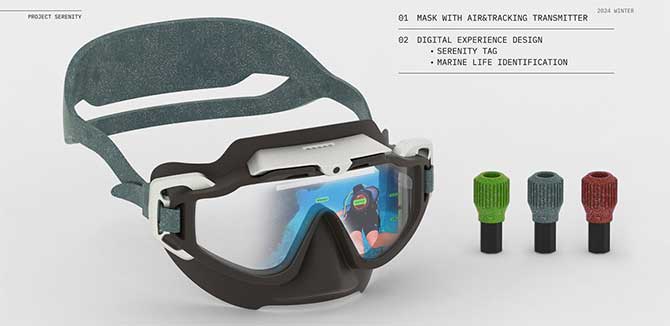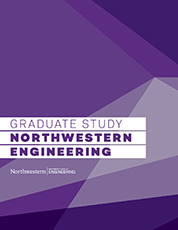Evolving Undersea Exploration
Elijah Li’s EDI thesis project led to a new scuba mask that would increase safety, improve navigation, and enrich educational opportunities provided by the underwater world.

Elijah Li (EDI '24) calls himself a strategic user interface (UI) and user experience (UX) designer who creates unique experiences.
For his Thesis project in Northwestern's Master of Science in Engineering Design Innovation (EDI) program, those unique experiences were underwater.
Li created Subaqueous Serenity to reimagine the scuba diving experience using augmented reality (AR) technology. The goal was to eliminate barriers that prevent divers from fully engaging with the underwater world and make scuba diving more accessible, enjoyable, and safe.
"The core problem Subaqueous Serenity addresses is the emotional stress and safety concerns that plague divers due to equipment issues, navigational difficulties, and potential threats from marine life," Li said. "Traditional diving gear, while functional, often lacks the ability to provide divers with real-time information and guidance, leaving them vulnerable to disorientation and danger."
Li created a mask system integrated with AR that offers enhanced communication, simplified navigation, and enriching interaction opportunities with marine life.
The final product is not what Li originally envisioned.
“Initially, the project was heavily focused on addressing safety and navigational challenges,” he said. “However, as the project developed, it became clear that enhancing the emotional and educational aspects of diving was equally important.”
That shift came by applying human-centered design — a core component of the EDI curriculum. Human-centered design encourages designers to put the end users in mind and then create something that addresses that user's pain points.
To do that, Li talked with scuba divers about their wants and needs. What he heard was divers wanted not just a safe experience, but an enhanced one as well.
"As a result, the project expanded its scope to include features that foster a deeper connection with marine life and promote a more immersive and meditative diving experience,” he said. “This reflected a holistic approach to redesigning the scuba diving experience.”
Thesis projects are meant to be a deep dive — in Li's case, literally — into a topic of personal interest for students. They have two quarters to focus on the project, culminating in a presentation to classmates, faculty, and industry advisers.
Li's project faced a number of initial challenges.
"Ensuring the mask could withstand the extreme pressures of deep-water environments while maintaining clear, reliable digital displays required innovative engineering and materials science solutions," he said. "Additionally, developing a digital interface that divers could intuitively interact with under various underwater conditions demanded careful consideration of usability and accessibility. Balancing these technical demands with the need for a sustainable, aesthetically pleasing design represented a complex challenge that pushed the boundaries of existing diving equipment."
While Li currently works as a brand and UI/UX designer for General Motors, he's still thinking about opportunities to further enhance Subaqueous Serenity.
“The project's success opens up possibilities for partnerships with diving organizations, educational institutions, and technology companies to bring this innovative solution to the wider diving community,” he said. “It highlights the importance of continuing research and development in the field of augmented reality and underwater exploration, pointing towards a future where technology and design work hand-in-hand to enhance human experiences in every environment."

